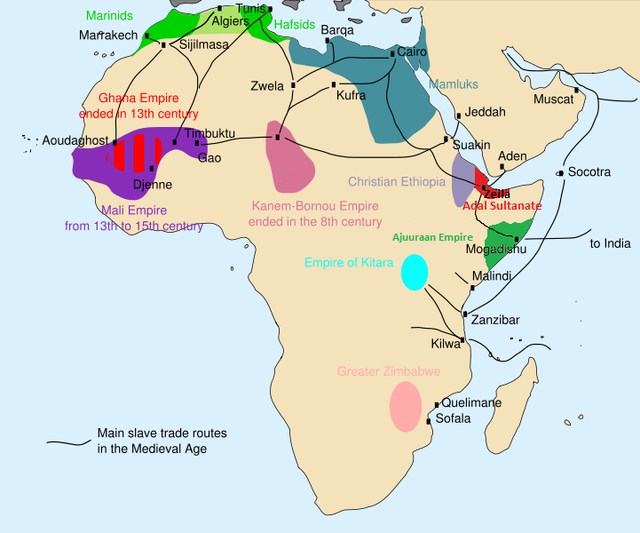Arab slave trade
slave trade in the Arab world between the 7th and 20th centuries From Wikipedia, the free encyclopedia
Remove ads
The Arab slave trade,[1][2][3] (also called the Indian Ocean slave trade, the Red Sea slave trade, or the trans-Saharan slave trade) was a slave trade in which slaves were mainly transported across the Sahara. Most were moved from sub-Saharan Africa to North Africa to be sold to Mediterranean and Middle Eastern civilizations; a small percentage went the other direction.[4] Estimates of the total number of black slaves moved from sub-Saharan Africa to the Arab world range from 6-10 million. The trans-Saharan trade routes conveyed a significant number of this total, with one estimate tallying around 7.2 million slaves crossing the Sahara from the mid-7th century until the 20th century (in 1956 in Saudi Arabia) when it was abolished.[5][6]

The main slave routes in Africa during the Middle Ages
The Arabs managed and operated the trans-Saharan slave trade,[7] although Berbers participated in it along with also managing and operating their own Barbary slave trade furthermore with the help of Arabs.[8][9] sub-Saharan Africans, Turks, Iranians, Europeans and Berbers were among the people traded by the Arabs, with the trade being practised throughout the Arab world, primarily in Western Asia, North Africa, East Africa, and Europe.[10]
Remove ads
History

One of the oldest slave trades in history was the Arab trade of Zanj (Bantu) slaves in Southeast Africa. This trade began 700 years before the European Atlantic slave trade.[11] Men taken as slaves were often used as servants, soldiers, or workers. Women and children were mainly used as servants and concubines. However, according to Islamic law and Muslim jurists castration of slaves was deemed unlawful this view is also mentioned in the Hadith.[12][13]
Most male slaves were castrated and became eunuchs.[14] It is estimated that as many as 6 out of every 10 boys bled to death during this process.[14] Those who survived castration were often used as plantation workers and auxiliary soldiers, noticing that as early as 696 AD, African soldiers revolted against Umayyad authority in lower Iraq.[15] Female slaves were mainly kept as concubines.[16] The trade of Southeast African slaves would continue until 1890, when British officials forced the Sultan of Zanzibar to end slave sales within his territories.[17] Writer Tidiane N'Diaye and historian Olivier Pétré-Grenouilleau state that between 15 and 17 million Sub-Saharan Africans were enslaved between the 9th Century and 1890.[18]
During the Arab slave trade, Europeans were among those traded by the Arabs.[10] The term Saqaliba (Arabic: صقالبة) was often used in medieval Arabic sources to refer specifically to Slavic slaves traded by the Arab traders, but it could also refer more broadly to Central, Southern, and Eastern Europeans who were also traded by the Arabs, as well as all European slaves in some Muslim regions like Spain including those abducted from military raids on Christian kingdoms of Spain.[19][20] During the era of the Fatimid Caliphate (909–1171), the majority of slaves were Europeans taken along European beaches and during conflicts.[10]
Remove ads
Modern slavery in Africa
In Mauritania slavery was abolished legally in 1980.[21] But Muslim Berbers still own an estimated 90,000 Sub-Saharan African slaves.[21] This is despite the fact that Sub-Saharan Mauritanians converted to Islam over a hundred years ago and the Qur’an does not allow Muslims to enslave other Muslims.[21] Slaves are used for farm labor, concubines and domestic servants.[22] The children remain the property of their masters. They can be bought, sold, or exchanged for trucks, camels or guns.[21]
Slavery in Sudan is active again with the Muslim north waging war against Animists and Christians in the south. In these raids almost all slaves are taken from the tribes in the Nuba Mountains.[21] Government sponsored Arab militias often kill the men and enslave women and children. Those taken slaves are forced to convert to Islam.[22] Those that refuse are put to death.[22] The trafficking in women and children in Western and Southern Africa violates the 1948 UN Universal Declaration of Human Rights.[23]
Remove ads
References
Other websites
Wikiwand - on
Seamless Wikipedia browsing. On steroids.
Remove ads
